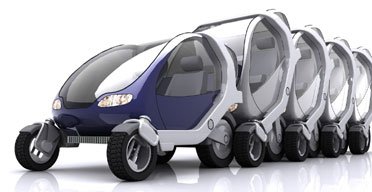XO Korea/XO city
환영합니다 | Portal | XO Korea | Deployment | Content | Hardware | Software | Mesh Network | Ethics | LOS | XO City | Accreditation | Consortium
 Stackable Concept Car of MIT Medialab
Stackable Concept Car of MIT Medialab
The content below is just a game idea, rather than a real project, and no relation with the OLPC Foundation. I also hope the content below to be used as an educational idea about the overview of city design, construction, and management for children;just like SimCity. Freely add your opinion on this page and discussion page also.
Introduction
From the aspects of economics, environment, and well-being of mankinds, being developed are quite a lot of revolutionary products such as stackable cars, XO mesh networks, and intelligent buildings etc. Also are revolutionary services and social infrastructures such as e-Government, e-Learning, e-Accreditation, and quite a few others.
But, how to deploy or adopt those revolutionary things into our lives? Can those stackable cars run onto our current highway systems? with giant trucks running side by side? Nonsense...
We need a new bottle to put those things in. That's the XO-like city we plan to construct.
City Design
XO City assumes to have 100,000+ population, producing most of goods and services it needs.
Energy
The motto of XO city is XO like city from all aspects. As the energy efficiency of savings of XO is 10 times better than most of current laptops, XO City also should be the same; it should have 10 times better energy circulation mechanism. How? from the three aspects below;
- eliminating unnecessary energy consumption. Then, which are those unnecessary?
- if there is a more energy-efficient alternative to do the same work (process or service)
- if there is a more energy-efficient physical rearrangement of buildings and roads to achieve the same value production
- if there is a more energy-efficient social value production system
The three options above are incremental rather than exclusive.
For example, if, for the purpose of citizens' going to and coming back from offices or fields everyday, XO City adopt MIT's stackable concept cars using electricity instead of ordinary gas-driven autos, the total energy consumption of transportation system using cars of our XO City will be at least 3 times lower or three times energy efficient.
Then, there also is the second alternative left.
Why citizens should use cars to go to & come from offices everyday? Why students should go to school everyday? By restructuring or designing the arrangement of buildings, housings, offices, factories, and schools etc., we can secure additonal energy savings...saying now we have reached 7~8 times better energy efficiency.
Now, the most important solution left; the restructuring of social system; exactly speaking, Social System for Value Production.
By substituting the total Intangible social infrasturcture (such as governments, banks, schools, health cares, insurances, broadcasting, journals, publications, and even business processes) with web-based services in the form of XO Activities
The main focus of XO Korea is that; transforming current social infras into XO Activities.
Road & City Railway
The Road/Street Plan of XO City can't be seperated from that of logistics and City Railway.
Firstly, City Railway will be the backbone of the transporation system; for passengers, products, and others.
Secondly, Stackable Cars link Railway Station and buildings/sites. Road System is for this purpose.
Thirdly, Logistics System does another key role; transporting all non-human materials. Of course, human being also is a special material under transportation.
So, there are three principles related to the Road System.
- Central road (maybe wide enough) with City Railway running on it. This City Railway becomes both human and product transporation backbone.
- Branch road (maybe rather narrow ones) on which Stackable Cars and people are running or walking between Railyway Station and buildings.
- Underground logistics system to transport things between Railway Station and buildings.
Of course, all transporting devices/vehicles shall be equipped with XO Traffic Controller, which enables driver-less driving.
In summary, if comparing Road System with the XO architecture, then;
- Stacable Car & City Railway Vehicle = XO Laptop
- Road = Mesh Network
- County Traffic Control = School Server
- Local Traffic Control = Local Server
- Central Traffic Control = Country Server
Stackable Car
City Railway Vehicle
County Traffic Control
Local County Traffic Control
Central Traffic Control
Logistics
The Key of logistics system in XO City is that all are XO based. Logistics processes should contribute to the energy efficiency and efficient value production processes of XO City constituents. How?
- All buildings (and all rooms in a building) in the city are linked by Logistics Tunnel, small railway system capsuled with pipes.
- XO Container transports big or small products; there will be various types of containers from the aspect of size, functionality, and other features such as waterproof etc.
- The movement of all containers in XO City will be contolled by the Building Logistics Control, Local Logistics Control and Central Logistics Control
- All XO Containers are XO Variations; that means those containers also are XOs.
In summary, if comparing Logistics System with the XO architecture, then;
- XO Containers = XO
- Logistics Tunnel = Mesh Network
- Building Logistics Control = School Server
- Local Logistics Control = Local Server
- Central Logistics Control = Country Server